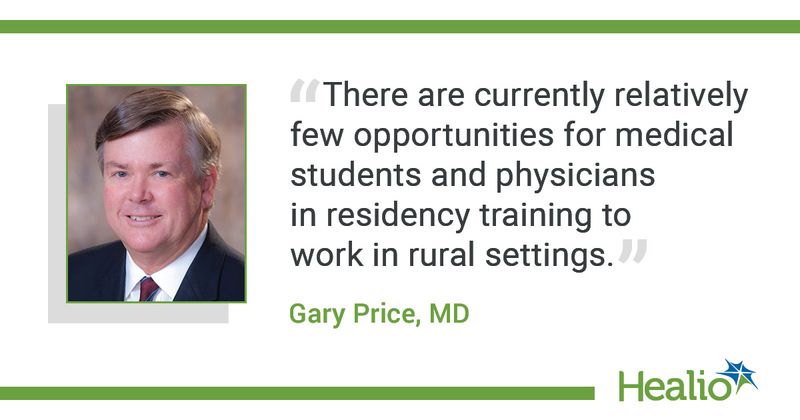Q&A: Collaboration seeks to boost number of PCPs in rural Ohio
Rural-urban disparities in the United States’ primary care workforce are on the rise, prompting experts to call for improvements and programs that encourage clinical practice in rural areas.
“There are currently relatively few opportunities for medical students and physicians in residency training to work in rural settings,” Gary Price, MD, president of The Physicians Foundation and clinical assistant professor of surgery at Yale-New Haven Hospital, told Healio Primary Care.

A new collaboration between Wright State University’s Boonshoft School of Medicine and Family Health Services of Darke County is seeking to augment the number of primary care physicians in nonurban locations. The Ohio-based institutions are using a Health Resources and Services Administration grant worth $750,000 to establish a rural family medicine residency program.
“When this opportunity came along to collaborate with Wright State and start a residency program, we were very excited to do so,” said Carlos Menendez, MD, the medical director at Family Health Services of Darke County in Ohio and the residency program’s director.

In an interview with Healio Primary Care, Menendez discussed the program’s creation, curriculum, applicant selection process and more.
Q: What led to the creation of this program?
A: Family Health Services is in Greenville, Ohio, about 35 miles outside of Dayton, Ohio. It has been growing steadily over the years to include several group practices, 13 clinicians and 10 allied professionals.
We have always taught medical residents and students aspiring to be physician assistants or nurse practitioners. When this opportunity came along to collaborate with Wright State and to start a residency, we saw the benefits of teaching and training future primary care physicians in rural areas. Hopefully upon completion of the residency, some of the residents will stay with Family Health Services and in the community.
Q: What will the curriculum entail?
A: The curriculum involves mostly didactics, caring for patients longitudinally as well as on hospital rotations, with supervision and support from experienced mentors in primary and specialty care. The new residency program will be a 1-2 rural training track, which gives learners the opportunity to train in a resource-rich urban center in the first year and in a relationship-rich rural community over time, preparing resident physicians to practice in a variety of challenging settings
Q: How are participants chosen?
A: There will be an interviewing process where applicants will discuss their professional interests. Then on Match Day, there will be between two and four students matched to the Wright State University Rural Residency.
Q: How will you train students to address the opioid crisis?
A: The Midwest has been hit hard by the opioid epidemic, so training residents on how to treat patients with opioid use disorder will be an integral part of the program. The residents will spend time with our patients who are being treated for opioid use disorder, receive behavioral health training to counseling these patients and take part in our needle exchange program that allows opioid users to have a physician with them and a clean needle to use each time they use these medications.
Q: What other efforts are needed to address the primary care shortage in rural areas?
A: We need to tell high school students that medicine, particularly primary care in rural areas, is a great field to get into. I went to the University of Dayton for the first part of my education, then went to Mount Sinai in New York City for my medical school training. Consequently, I received a scholarship that covered my medical education in return for a 4-year commitment to serve in an area where there is a shortage of primary care physicians and was placed in Greenville. The education I gained from this training and the location where I was placed landed me in a career that turned out to be my dream job. My time here has been incredibly rewarding and I very much look forward to sharing this experience with new physicians and hope they find the same fulfillment I have been blessed to find.
Editor’s note: This article is part of an ongoing series spotlighting people and institutions who are making innovations in primary care. If you or your institution are taking important steps to improve the quality and cost of care in the primary care setting, email us at primarycare@e.healio.com .
References
Schroeder KR. There’s a shortage of local rural doctors. WSU program aims to help. https://www.daytondailynews.com/news/theres-a-shortage-of-local-rural-doctors-wsu-program-aims-to-help/TKESM3MSCRCPZOX3VE643QKUPA/. Accessed November 11, 2020.
Wright State University Newsroom. Boonshoft School of Medicine to begin Rural Family Medicine Residency Program. https://webapp2.wright.edu/web1/newsroom/2020/09/29/boonshoft-school-of-medicine-to-begin-rural-family-medicine-residency-program/. Accessed November 11, 2020.
